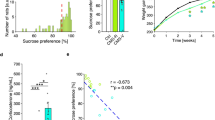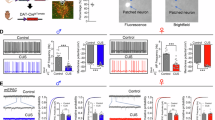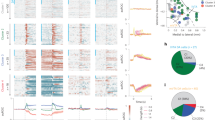Abstract
The dopamine (DA) neurons in the ventral tegmental area and medial substantia nigra (VTA/mSN) projecting to the limbic forebrain and prefrontal cortex have long been postulated to play a major role in cognitive and behavioral effects of stress. In this study, the effects of a chronic stressor (prolonged exposure to cold) on the spontaneous activity of DA neurons in the VTA/mSN were examined. Extracellular single-unit recordings of DA neurons were performed in rats following a 17-day continuous exposure to a cold (4°C) environment. Compared to controls, cold-exposed rats displayed 64% fewer spontaneously active DA neurons. The average spike activity (average firing rate, average spikes fired in bursts) of the DA cells that remained active in the cold-exposed rats did not differ significantly from controls. However, a significantly larger proportion of those cells showed excessive burst activity, compared to the DA cell population in controls. These results show that chronic stress can lead to the cessation of spontaneous activity in a subpopulation of VTA/mSN DA cells. These changes may indicate that unlike acute stress, which can potently activate the mesolimbic/mesocortical DA systems, chronic stress leads to an adaptive reduction in the number of active DA cells, perhaps altering the response of these systems to subsequent stressors.
Similar content being viewed by others
Log in or create a free account to read this content
Gain free access to this article, as well as selected content from this journal and more on nature.com
or
References
Abercrombie ED, Keefe KA, DiFrischia DS, Zigmond MJ . (1989): Differential effect of stress on in vivo dopamine release in striatum, nucleus accumbens, and medial frontal cortex. J Neurochem 52: 1655–1658
Anisman H, Zacharko RM . (1990): Multiple neurochemical and behavioral consequences of stressors: Implications for depression. Pharm Theapeutics 46: 119–136
Brown GW . (1993): The role of life events in the aetiology of depressive and anxiety disorders. In Stanford SC, Salmon P (eds), Stress: From Synapse to Syndrome. London, Academic Press, pp 24–52
Bunney BS, Walters JR, Roth RH, Aghajanian GK . (1973): Dopaminergic neurons: Effect of antipsychotic drugs and amphetamine on single cell activity. J Pharmacol Exper Ther 49: 560–571
Cabib S, Puglisi-Allegra S . (1996): Different effects of repeated stressful experiences on mesocortical and mesolimbic dopamine metabolism. Neuroscience 73: 375–380
Chen HT, Kandasamy SB . (1996): Effect of chloral hydrate on in vivo KCl-induced striatal dopamine release in the rat. Neurochemical Res 21: 695–700
Craig KJ, Brown KJ, Baum A . (1995): Environmental factors in the etiology of anxiety. In Bloom FE, Kupfer DJ (eds), Psychopharmacology: The Fourth Generation of Progress. New York, Raven Press, pp 1325–1340
Curtis AL, Pavcovich LA, Valentino RJ . (1999): Long-term regulation of locus ceruleus sensitivity to corticotropin-releasing factor by swim stress. J Pharmacol Exper Ther 289: 1211–1219
Dallman MF, Bhatnagar S, Viau V . (2000): Hypothalamo-pituitary-adrenal axis. In Fink G (ed), The Encyclopedia of Stress, vol 2, San Diego, Academic Press, pp 477–483
Dunn AJ, File SE . (1983): Cold restraint alters dopamine metabolism in frontal cortex, nucleus accumbens and neostriatum. Physiol Behav 31: 511–513
Fallon JH, Loughlin SE . (1995): The subtantia nigra. In Paxinos G (ed), The Rat Nervous System. San Diego, Academic Press, pp 215–238
Finlay JM, Zigmond MJ . (1997): The effects of stress on central dopaminergic neurons: possible clinical implications. Neurochemical Res 22: 1387–1394
Finlay JM, Zigmond MJ, Abercrombie ED . (1995): Increased dopamine and norepinephrine release in medial prefrontal cortex induced by acute and chronic stress: Effects of diazepam. Neuroscience 64: 619–628
Fluharty SJ, Snyder GL, Zigmond M, Stricker EM . (1985): Tyrosine hydroxylase activity and catecholamine biosynthesis in the adrenal medulla of rats during stress. J Pharmacol Exper Ther 233: 32–38
Gao DM, Jeaugey L, Pollak P, Benabid AL . (1990): Intensity-dependent nociceptive responses from presumed dopaminergic neurons of the substantia nigra, pars compacta in the rat and their modification by lateral habenula inputs. Brain Res 529: 315–319
Gonon FG . (1988): Nonlinear relationship between impulse flow and dopamine release by rat midbrain dopaminergic neurons as studied by in vivo electrochemistry. Neuroscience 24: 19–28
Grace AA . (1991): Phasic versus tonic dopamine release and the modulation of dopamine system responsivity: A hypothesis for the etiology of schizophrenia. Neuroscience 41: 1–24
Grace AA, Bunney BS . (1983): Intracellular and extracellular electrophysiology of nigral dopaminergic neurons—1. Identification and characterization. Neuroscience 10: 301–315
Grace AA, Bunney BS . (1984): The control of firing pattern in nigral dopamine neurons: burst firing. J Neuroscience 4: 2877–2890
Grace AA, Bunney BS, Moore H, Todd CL . (1997): Dopamine cell depolarization block as a model for the therapeutic actions of antipsychotic drugs. Trends Neuroscience 20: 23–30
Grace AA, Hommer DW, Bunney BS . (1980): Peripheral and striatal influences on nigral dopamine cells: Mediation by reticulata neurons. Brain Res Bull 5(Suppl 2):105–109
Grenoff J, Nisell M, Ferre S, Aston-Jones G, Svensson TH . (1993): Noradrenergic modulation of midbrain dopamine cell firing elicited by stimulation of the locus coeruleus in the rat. J Neural Transm 93: 11–25
Gresch PJ, Sved AF, Zigmond MJ, Finlay JM . (1994): Stress-induced sensitization of dopamine and norepinephrine efflux in medial prefrontal cortex in the rat. J Neurochem 63: 575–583
Herman JP, Guillonneau D, Dantzer R, Scatton B, Semerdjian-Rouquier L, LeMoal M . (1982): Differential effects of inescapable footshock and of stimuli previously paired with inescapable footshock on dopamine turnover in cortical and limbic areas of the rat. Life Sci 30: 2207–2214
Horger BA, Roth RH . (1996): The role of mesoprefrontal dopamine neurons in stress. Critical Rev Neurobiol 10: 395–418
Imperato A, Angelucci L, Casolini P, Zocchi A, Puglisi-Allegra S . (1992): Repeated stressful experiences differently affect limbic dopamine release during and following stress. Brain Res 557: 194–199
Imperato A, Cabib S, Puglisi-Allegra S . (1993): Repeated stressful experiences differently affect the time dependent responses of the mesolimbic dopamine system to the stressor. Brain Res 601: 333–336
Jedema HP, Finlay JM, Sved AF, Grace AA . (2001): Chronic cold exposure potentiates CRH-evoked increases in electrophysiological activity of locus coeruleus neurons. Biological Psychiatry, 49
Jedema HP, Sved AF, Zigmond MJ, Finlay JM . (1999): Sensitization of norepinephrine release in medial prefrontal cortex: Effect of different chronic stress protocols. Brain Res 830: 211–217
Maeda H, Mogenson GJ . (1982): Effects of peripheral stimulation or the activity of neurons in the ventral tegmental area, substantia nigra and midbrain reticular formation of rats. Brain Res Bull 8: 7–14
Maier SF, Seligman MEP . (1976): Learned helplessness: Theory and evidence. J Exp Psychol (Gen) 1: 3–46
Mana MJ, Grace AA . (1997): Chronic cold stress alters the basal and evoked electrophysiological activity of rat locus coeruleus neurons. Neuroscience 8: 1055–1064
Mantz J, Thierry AM, Glowinski J . (1989): Effect of noxious tail pinch on the discharge rate of mesocortical and mesolimbic dopamine neurons: Selective activation of the mesocortical system. Brain Res 476: 377–381
Mizoguchi K, Yuzurihara M, Ishige A, Sasaki H, Chue D, Tabira T . (2000): Chronic stress induces impairment of spatial working memory because of prefrontal dopaminergic dysfunction. J Neuroscience 20: 1568–1574
Moore H, Todd CL, Grace AA . (1998): Extracellular dopamine in the striatum of rats with haloperidol-induced depolarization block in substantia nigra dopamine neurons. J Neuroscience 18: 5068–5077
Moore H, West AR, Grace AA . (1999): The regulation of forebrain dopamine transmission: relevance to the pathophysiology and psychopathology of schizophrenia. Biol Psychiatry 46: 40–55
O'Conner FW . (1991): Symptom monitoring for relapse prevention in schizophrenia. Arch Psychiatric Nursing 5: 193–201
Ortiz J, Fitzgerald LW, Lane S, Terwilliger R, Nestler EJ . (1996): Biochemical adaptations in the mesolimbic dopamine system in response to repeated stress. Neuropsychopharmacology 14: 443–452
Ottenweller JE . (2000): Animal models (nonprimate) for human stress. In Fink G (ed), Encyclopedia of Stress, vol 1, San Diego, Academic Press, pp 200–205
Quick JD, Horn RS, Quick JC . (1986): Health consequences of stress. J Organiz Behav Manag 8: 19–36
Piercey MF, Broderick PA, Hoffmann WE, Vogelsang GD . (1990): U-66444B and U-68553B, potent autoreceptor agonists at dopaminergic cell bodies and terminals. J Pharmacol Exper Ther 254: 369–374
Porsolt RD, Le Pinchon M, Jalfre M . (1977): Depression: A new animal model sensitive to antidepressant treatments. Nature 266: 730–732
Richard F, Faucon-Biguet N, Labatut R, Rollet D, Mallet J, Buda M . (1988): Modulation of tyrosine hydroxylase gene expression in rat brain and adrenals by exposure to cold. J Neuroscience Res 20: 32–37
Roth RH, Tam SY, Ida Y, Yang JX, Deutch AY . (1988): Stress and the mesocorticolimbic dopamine systems. Ann N Y Acad Sci 537: 138–147
Seeman P, Lee T, Chau-Wong M, Wong K . (1976): Antipsychotic drug doses and neuroleptic/dopamine receptors. Nature 261: 717–719
Simson PE, Weiss JM . (1988): Altered activity of locus coeruleus in an animal model of depression. Neuropsychopharmacology 1: 287–295
Stanford SC . (1993): Monoamines in response and adaptation to stress. In Stanford SC, Salmon P (eds), Stress: From synapse to syndrome. London, Academic Press, pp 24–52
Suaud-Chagny MF, Chergui K, Chouvet G, Gonon F . (1992): Relationship between dopamine release in the rat nucleus accumbens and the discharge activity of dopaminergic neurons during local in vivo application of amino acids in the ventral tegmental area. Neuroscience 49: 63–72
Thierry AM, Tassin JP, Blanc G, Glowinski J . (1976): Selective activation of mesocortical DA system by stress. Nature 263: 242–244
Tissari AH, Argiolas A, Fadda F, Serra G, Gessa GL . (1979): Foot-shock stress accelerates non-striatal dopamine synthesis without activating tyrosine hydroxylase. Arch Pharmacology 308: 155–157
Van Zoeren JG, Stricker E . (1977): Effects of preoptic, lateral hypothalamic, or dopamine-depleting lesions on behavioral thermoregulation in rats exposed to the cold. J Comp Physiol Psychol 91: 989–999
West AP . (1990): Neurobehavioral studies of forced swimming: The role of learning and memory in the forced swim test. Prog Neuropsychopharmacol Biol Psychiatry 14: 863–877
Willner P . (1995): Dopamine mechanisms in depression and mania. In Bloom FE, Kupfer DJ (eds), Psychopharmacology: The Fourth Generation of Progress. New York, Raven Press, pp 921–932
Yehuda R, Antelman SM . (1993): Criteria for rationally evaluating animal models of posttraumatic stress disorder. Biol Psychiatry 33: 479–486
Zigmond RE, Schon F, Iversen LL . (1974): Increased tyrosine hydroxylase activity in the locus coeruleus of rat brainstem after reserpine treatment and cold stress. Brain Res 70: 547–552
Zubin J, Spring B . (1977): Vulnerability—a new view of schizophrenia. J Abnormal Psychol 86: 103–126
Acknowledgements
Research was supported by Howard Hughes Undergraduate Fellowship (HJR), a National Association for Research on Schizophrenia and Depression Young Investigator award (HM), an NIMH Individual NRSA (HM), and USPHS grants MH 45156, 29670 and 57440 (AAG). The authors thank Nicole MacMurdo for her technical assistance, Brain Lowry for development of Neuroscope© physiological data analysis software, and Hank Jedema for his critical comments on an earlier version of this manuscript.
Author information
Authors and Affiliations
Rights and permissions
About this article
Cite this article
Moore, H., Rose, H. & Grace, A. Chronic Cold Stress Reduces the Spontaneous Activity of Ventral Tegmental Dopamine Neurons. Neuropsychopharmacol 24, 410–419 (2001). https://doi.org/10.1016/S0893-133X(00)00188-3
Received:
Revised:
Accepted:
Issue date:
DOI: https://doi.org/10.1016/S0893-133X(00)00188-3
Keywords
This article is cited by
-
Analysis of Molecular Circuitry Integrated to Lethargus State of Caenorhabditis elegans: A Review
Proceedings of the Zoological Society (2024)
-
Dopamine transporter blockade during adolescence increases adult dopamine function, impulsivity, and aggression
Molecular Psychiatry (2023)
-
Insights into the Involvement and Therapeutic Target Potential of the Dopamine System in the Posttraumatic Stress Disorder
Molecular Neurobiology (2023)
-
Repeated chemogenetic activation of dopaminergic neurons induces reversible changes in baseline and amphetamine-induced behaviors
Psychopharmacology (2023)
-
Restraint Stress Potentiated Morphine Sensitization: Involvement of Dopamine Receptors within the Nucleus Accumbens
Neurochemical Research (2021)



